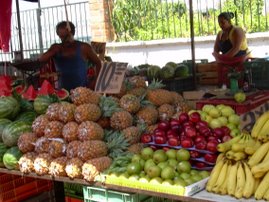
Now that we are soon to be invested in the Lake Chapala area permanently, as homeowners, I have been wondering what the future holds for Ajijic. Perhaps the most startling thing about this village is that, in spite of all the gringos who have moved into town, it remains very Mexican. As I walk into town from our rental on the West side, I walk through "Seis Esquinas," Six Corners, a very Mexican neighborhood, and see the rhythms of Mexican life continuing in spite of the influx from the North: the old man cutting sugar cane, coconut, and nopal cactus to sell at his fruit stand, two old women in robozos chatting through a metal door, schoolchildren in their plaid uniforms and their backpacks holding their mothers' hands on their way to school, my friend Salvadore washing his horse and smiling to me with his gold front teeth, young men mixing cement with sand on the cobblestone street....hardly the image of a retirement community. Of course, I do see the gringos, like me, in their straw hats, walking their dogs, shopping at the little grocery stores, mixing comfortably with their Mexican neighbors.
Of course, many of the American, Canadian, and European expats tend to live outside the village in "fracciomentos" or gated neighborhoods east, west, and north of the village. We found homes in Ajijic to be unaffordable and with little or no outside space. Wealthy gringos are slowly buying up Mexican property and gutting the homes, transforming them into colorful showcases among the grey, cement Mexican homes.
The main road, or Carretera, which runs along the north shore of Lake Chapala connecting Ajijic to Jocotepec to the west and Chapala to the east, and beyond, is congested, particularly now when the population swells with the seasonal visitors. But even in the summer, the road is inadequate for its traffic. More and more gringo-oriented businesses are popping up to try to capitalize on the retirement migration.
The house we are buying is in Riberas del Pilar, between Ajijic and Chapala. The area is not very built up at the moment, although clearly, many houses are starting to be built in this area. There are many businesses along the Carretera in Riberas.
I try to imagine what the north shore, between Jocotepec and Chapala will be in ten or twenty years. The pace of influx of Northerners has abated a bit, probably because of the poor housing market in the US. If people can't sell their homes in the United States, they cannot afford to pay cash for a house in Mexico. Of course, the Canadian market is better, but overall, real estate here is selling slowly. For example, we were able to get our house for $30,000USD below the original asking price. But eventually, as more baby boomers retire, Mexico, and this area in particular, will become an increasingly popular retirement destination. The prices will probably keep going up, at least somewhat. There are new developments popping up all along the carretera, and I expect that, in the future, the entire corridor between Ajijic and Jocotepec will be developed.
The big worry is will the infrastructure be able to handle it? Will the water and sewer systems be adequate? Is the Mexican government planning for this increase in population? They are clearly glad to have the expats coming here, and I am sure planning is going on, but it is a huge challenge.
I am afraid that Ajijic itself will have to change as time goes on. As the limited space in the village is bought up, and the value of the property continues to increase, there will be more pressure on Mexican families to sell to assure their economic future. As this happens, the village will, inevitably, become where gringos live and Mexicans work. I hope this does not happen, but I think it likely will, eventually.
As the area becomes less Mexican, prices will probably rise, as has the price of real estate. Probably the best argument for us to buy a home here is to avoid getting priced out of the housing market. Rentals are reasonable now, but are likely to go up in the future.
We're betting that, in spite of the challenges ahead, the Lake Chapala area will continue to be a wonderful place to live. Certainly living in the US has its own challenges. The weather here, without the need for heat or AC, will continue to help us live simply. The abundance of fresh fruits and vegetables and fresh meats will continue to help us eat well. And, most of all, the beautiful, generous, and kind Mexican people will keep us here. As case in point: we shop at the outside market every week. Last week we inadvertently left a bunch of Bananas behind. This week when we returned, Aaron, the man who we buy our fruits and veggies from, shouted out: "Bill! Pixie! You left your bananas last week. Here, I have a new bunch for you today!" I hope this type of kindness never changes.
Finally, I am including a recent poem I wrote after Eric and Crystal brought the latest ultrasound image of Isabelle for us to see.
Isabelle
As we gather intently around the screen
To view the grainy disk
Your parents brought to
To demonstrate their fertility.
You do not know the world
Into which you are about
To be thrust.
Will you shine or struggle?
I think I see your foot
And now perhaps your face
Inscrutable and silent
Reserving judgment on us all.
Your heart, tiny and furious
Belies your otherwise buoyant repose
And I wish I know
What it will hold dear,
How often it will break,
If it will carry you well
Through tears and tragedy,
And how it will pound with passion
Against some lover’s breast
In darkest nights ahead.
I think I see translucent eyes
Peering into vacant space
And I wonder what they’ll see
Eighty years from now
When we are gone and you remain.
What will you think of us?



































































No comments:
Post a Comment